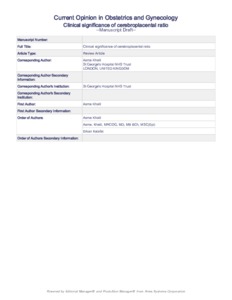Kalafat, E; Khalil, A
(2018)
Clinical significance of cerebroplacental ratio.
Curr Opin Obstet Gynecol, 30 (6).
pp. 344-354.
ISSN 1473-656X
https://doi.org/10.1097/GCO.0000000000000490
SGUL Authors: Khalil, Asma
![[img]](https://openaccess.sgul.ac.uk/110555/1.hassmallThumbnailVersion/Clinical%20significance%20of%20cerebroplacental%20ratio%20submitted%20current%20opinion%20in%20obstetrics%20and%20Gyn.pdf)  Preview |
|
PDF
Accepted Version
Available under License ["licenses_description_publisher" not defined].
Download (866kB)
| Preview
|
Abstract
PURPOSE OF REVIEW: Two-thirds of the pregnancies complicated by stillbirth demonstrate growth restriction. Identification of the foetus at risk of growth restriction is essential to reduce the risk of stillbirth. The aim of this review is to critically appraise the current evidence regarding clinical utility of cerebroplacental ratio (CPR) in antenatal surveillance. RECENT FINDINGS: The CPR has emerged as an assessment tool for foetuses at increased risk of growth disorders. CPR is a better predictor of adverse events compared with middle-cerebral artery or umbilical artery Doppler alone. The predictive value of CPR for adverse perinatal outcomes is better for suspected small-for-gestational age foetuses compared with appropriate-for-gestational age (AGA) foetuses. CPR could be useful for the risk stratification of small-for-gestational age foetuses to determine the timing of delivery and also to calculate the risk of intrapartum compromise or prolonged admission to the neonatal care unit. Although there are many proposed cut-offs for an abnormal CPR value, evidence is currently lacking to suggest the use of one cut-off over another. CPR appears to be associated with increased risk of intrapartum foetal compromise, abnormal growth velocity, and lower birthweight in AGA foetuses as well. Moreover, birthweight differences are better explained with CPR compared to other factors such as ethnicity. However, the role of CPR in predicting adverse perinatal outcomes such as acidosis or low Apgar scores in AGA foetuses is yet to be determined. SUMMARY: CPR appears to be a useful surrogate of suboptimal foetal growth and intrauterine hypoxia and it is associated with a variety of perinatal adverse events.
Statistics
Item downloaded times since 18 Jan 2019.
Actions (login required)
 |
Edit Item |



